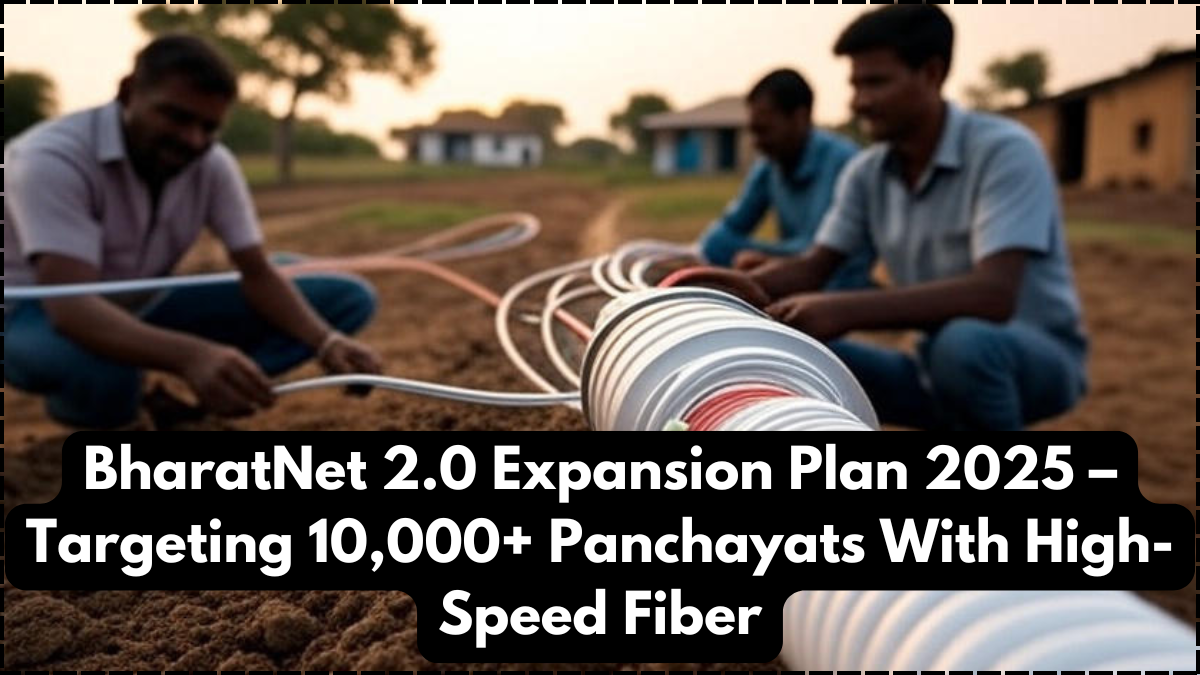India’s rural connectivity landscape is being transformed in 2025 with the nationwide BharatNet expansion 2025 project. Under phase 2 of this ambitious initiative, over 10,000 additional gram panchayats are being equipped with high‑speed fiber links, bringing village internet high speed to areas that have long suffered from digital exclusion. This fiber rollout is expected to fuel education, e‑governance, telemedicine, and local entrepreneurship in remote regions.
By leveraging existing infrastructure and reserving upgrades for underserved districts, BharatNet aims to create a resilient and scalable backbone. The current expansion will link panchayats through fiber-to-panchayat (FTTP) connectivity, enabling speeds up to 100 Mbps — a quantum leap from previous generations of narrowband or wireless access.

What the Expansion Includes
The BharatNet expansion 2025 is structured around four core service pillars: fiber deployment, local Wi-Fi hubs, edge server installations, and last-mile access for users. Panchayats will host Wi-Fi kiosks for public access, digital facilitation centers, and VoIP-enabled devices for tele-health and education. Importantly, fiber cables are being buried underground or mounted aerially where terrain allows, improving both speed and reliability.
Here’s a breakdown of the rollout scheme:
| Component | Coverage Target | Expected Bandwidth | Purpose |
|---|---|---|---|
| Fiber Links to Panchayat | 10,000+ locations | 100 Mbps symmetric | Backbone connectivity for all services |
| Wi-Fi Hotspots | 1 per panchayat | Shared 40 Mbps | Public access and community use |
| Edge Compute Nodes | 100 districts | Local caching | Reduced latency for eGov and content apps |
| VOIP Telehealth Units | 500 block centers | 50 Mbps | Remote consultation and diagnostics |
This integrated infrastructure ensures village internet high speed is not a promise but a usable reality for citizens and local institutions.
Impact Across Sectors
The enhanced connectivity through BharatNet expansion 2025 is expected to transform several domains:
-
Education: Remote schools can now stream live classes, access digital libraries, and conduct online exams.
-
Healthcare: Telemedicine kiosks allow rural patients to consult doctors in real time, receive e-pharmacy services, and handle lab diagnostics.
-
eGov & Civics: Panchayats can host public grievance portals, digital certificates, and remote administrative services.
-
Livelihoods: Farmers access weather alerts, price indices, market linkages, and agritech advisory platforms.
In trial districts, student engagement in digital learning rose by 35%, online certificate registrations rose by 50%, and tele-consultations surged by over 40%.
Implementation Strategy & Partnerships
State governments are collaborating with Bharat Broadband Network Limited (BBNL) to prioritize connectivity in lagging districts. A mix of central and state funding ensures costs are kept within budget, while local public works departments provide last-mile deployment support.
Training programs for local youth and panchayat IT coordinators are ongoing so technical issues can be handled locally. Solar-powered backup systems are being installed in areas with unreliable power, ensuring continuity even during outages.
Implementation targets include full fiber linkage to 10,000–12,000 panchayats by December 2025, followed by scaling to 2GJS tested live user access across digital services. This expansion is a strong push toward bridging the rural digital divide in meaningful ways.
Challenges and Community Integration
While the plan is comprehensive, success depends on proper adoption. Challenges such as user awareness, device availability, and local governance capacity persist. To address these, the BharatNet expansion 2025 program includes digital literacy camps, subsidized tablet distribution for schools, and training of community digital champions.
Local SHGs are being engaged to manage Wi-Fi points during community hours, enabling women-led livelihood programs like e‑commerce for crafts or agro-products. The objective is to make village internet high speed accessible not just in hardware terms, but through sustained use and community empowerment.
These support systems aim to ensure that internet access transitions from novelty to everyday necessity.
Conclusion
The BharatNet expansion 2025 marks a pivotal chapter in India’s rural digital transformation. By delivering high‑speed fiber to thousands of underserved panchayats, it finally promises true village internet high speed that can support education, governance, healthcare, and livelihoods. Through strategic partnerships, local training, and supportive usage models, the project is moving beyond infrastructure to instigate real digital equity. As these connectivity networks mature, rural India is poised for the next leap in inclusive development.
FAQs
What is BharatNet expansion 2025?
It is the government’s latest initiative to extend high‑speed fiber connectivity to over 10,000 rural panchayats across India in 2025.
What does village internet high speed mean?
It refers to internet speeds up to 100 Mbps being made available at panchayat halls and community zones via fiber and Wi-Fi hubs.
Who will benefit from this expansion?
Rural schools, health centers, panchayats, farmers, villagers, and local entrepreneurs will all gain access to improved digital infrastructure.
What services can users access over BharatNet?
Services include live education, telemedicine, e-governance portals, market information, and livelihoods support via connected platforms.
When will the project be complete?
The goal is to connect 10,000–12,000 panchayats by December 2025, with expanding coverage in subsequent phases.
Click here to learn more